Watching the color guard perform along with the marching band has always been one of my favorite things to do. Knowing all the hard work and effort the team has put into perfecting their routine makes it that much more enjoyable.
Color guard requires a lot of hard work, dedication, practice, marching skills, timing, and commitment!
I have seen firsthand how my daughter and her teammates have worked relentlessly putting countless hours into their craft. They have suffered injuries and worked tirelessly in the hot sun for days on end to hone their skills so their audience can enjoy a fantastic show!
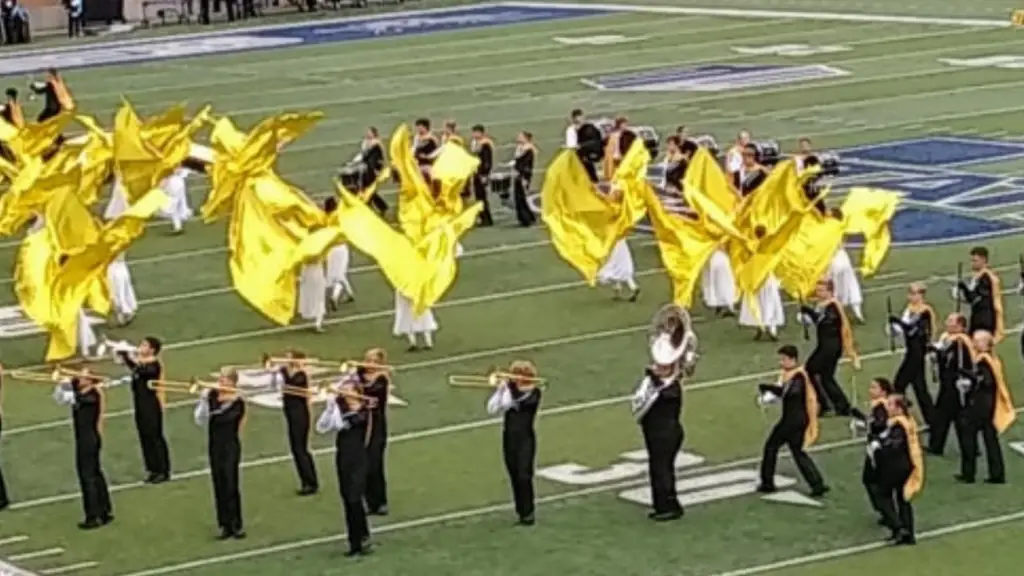
Here are 10 Reasons why being in color guard is so hard, & why all that hard work is worth it!
#1 Color Guard Requires a lot of Practice!
The number of practice hours that each color guard team requires will vary, but in general, you can expect to practice 10-30 hours a week.
My daughter’s color guard has team practices Monday-Friday for 1 hour every day. They practice with the marching band for 2 hours 4 times a week with occasional full-day practices, as well as 2-3 week-long camps in the summer.
All this team practice as well as practice with the band doesn’t include the time she puts into practice at home. On weekends when she doesn’t have a competition she is often practicing at home for 4-6 hours.
#2 Color Guard Requires Time Commitment
On top of all the practice that you will put into being a part of your color guard team, you will also have a big time commitment to make. Some of the things you will commit to when joining the color guard can include but are not limited to, are:
- Competitions – Often held weekly on Fridays Saturdays or Sundays.
- Traveling – Many teams will travel with their band and or football team to perform at away games. Traveling for competitions is often required as well.
- Planning – Team meeting to discuss planning and logistics of the organization, as well as plan and prep shows.
- Prepping for shows – Color guards tend to have extravagant uniforms that are much more than basic marching uniforms.
Teams often have a specific way they plan to do their hair and makeup. Sometimes wearing jewels or paint on their faces to match the show’s theme. This usually takes then 1-2 hours of extra prep time to get ready before every show. - Learning Drill – Besides the regular practices additional times are generally set aside to work on drills with the marching band.
- Team Bonding experiences – Color guard members will often become your best friends spending time with them doing fun things besides just practicing will be important to create stronger bonds.
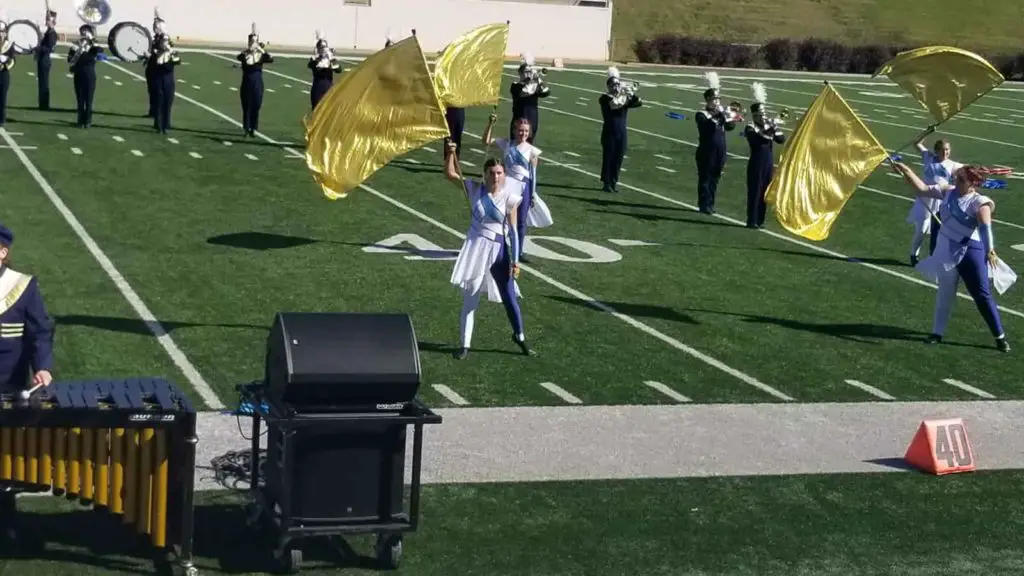
#3 Color Guard is Physically Demanding
If you are thinking about joining the color guard but you are not currently physically active you may want to prepare yourself.
Doing color guard is akin to doing a hard workout every practice. You will use muscles you never knew you had. It takes arm strength to toss and catch the flags. It takes leg strength to run and march across the field.
A color guard member can expect to burn between 170-250 calories an hour during an intense practice.
After the first few weeks/months you will be sore, but your muscles will eventually adapt and you will be that much stronger for it!
Top Tip: Don’t let the physical demands of color guard scare you away. If you are planning to join or try out for color guard start now by doing some exercise and strength training to help you prepare. Once you join being in color guard makes getting your daily exercise a lot more fun!
#4 Color Guard Requires Technical Skills
Color guard isn’t something that you can learn to do overnight. There are technical skills that you need to practice and hone over time.
The technical skills involved require:
- Correct body movement
- Correct posture
- Correct flag positioning
- Correct timing
Learning to march and do the moves and tosses together require excellent coordination and timing.
There are many different positions you need to learn. From basic flag movements to higher rifle tossing (quads, fifths, & sixes); learning advanced tosses with your flag, rifle, and sabre can be quite exciting.
#4 Color Guard Can be Dangerous (Injuries Happen)
Participating in color guard is relatively safe when done correctly. Especially compared with the number of injuries that happen in sports like football and hockey color guard would seem to be a lot less.
However, being a member of the color guard can be very dangerous if you don’t follow rules and precautions. A lot of color guard members we talked to described the injuries coming mostly from spinning the rifle or sabre.
Since The rifle and sabre are heavier and require much more skill to master a bad toss has a higher likelihood of hitting you on the head or landing on you incorrectly causing injury.
🎵 Note: Many color guards require their members to have at least 1 or 2 years of experience spinning flags before learning rifle or sabre to help prevent injuries.
Injuries that can and have happened to color guard members:
- Concussion
- Heat Exhaustion
- Extreme Sunburns
- Wounds that need stitches
- Headache
- Fatigue
- Hand and wrist injuries
- Torn ligaments
- Sprained ankles
- Cuts and bruises
Ways to prevent injuries in color guard:
- Wear gloves whenever you can
- Drink plenty of water
- Try not to practice too long in the sun, especially during hot temperatures
- Wear sunscreen
- Stretch before you practice
- Strengthen your core, and flexibility
- Use proper techniques
- Rest when needed
- Take proper time to recover from any previous injuries
Performing in color guard can be as taxing as being a cheerleader or on a competitive dance team. Taking time to stretch before you practice is essential to warm up your muscles.
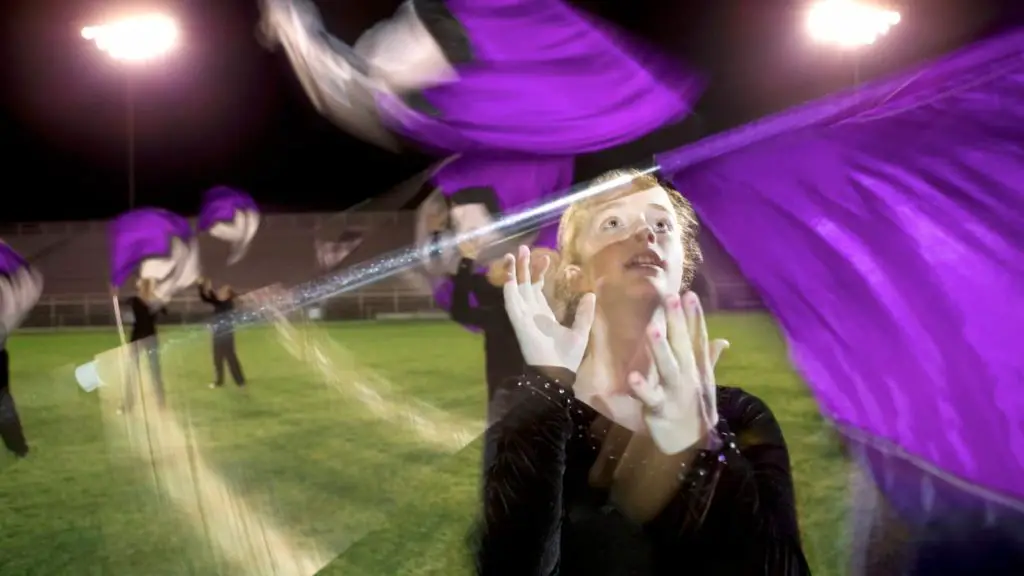
As with other sports doing strength training that will increase your core strength as well as your flexibility will not only increase your stamina, but help your body prepare for the rigorous moves that you need to make when tossing your flag, sabre, or rifle.
Top Tip: Color guard members need to be especially aware of windy conditions. Wind can make your flags come down in unexpected ways making them hard to catch. They may even fall onto and injure other band members.
#9 Color Guard is Expensive
If you are thinking color guard would be less expensive than playing an instrument in the marching band think again!
Band instruments are expensive! I know you may be wondering how can color guard be more expensive than buying a $3000 instrument?
Well, the truth of the matter is that even though a Saxophone player may have to purchase a $3000 instrument, that instrument will generally last throughout their high school and college career and even beyond if it is well taken care of.
Flags are tossed around, hit the ground, and are used so heavily that they generally only last one seeason.
A flag twirler has recurring expenses every year. Here are some of the costs involved in color guard:
- New flags – Flags change every year and each member of the color guard team usually has 3-5 flags per person per show.
- Rifles – Generally rifles can be used for many years if taken care of.
- Sabres– The cost for sabres vary, and can often be used year after year.
- Tape and weights – Flags will need to be weighted and taped correctly.
- Uniforms – Marching band uniforms generally stay the same for several years, for color guard they change every year.
- Shoes – Shoes for practice and shoes for performance.
- Gloves – Not all guards use gloves, but it can be helpful to protect your hands.
- Makeup & Hair stuff – specific to your costume or theme.
- Accessories – Color guard tends to have more accessories than other members of the band.
- Additional Fees– Administration fees, competition fees, etc.
Most color guards will add all the costs together and have you pay for the entire season in one flat fee. Some will section it out for different items. In total color guard fees range from $300-$2000 depending on how big the guard is, and what competitions they attend. This year my daughter’s fees were about $1000.

#5 Band Camp is Hard
The most grueling part of joining color guard is often the first few months. When color guard season starts (usually at the beginning of summer) you will start with fundamentals week. In fundamentals week, experienced guard members will teach new members all the basic moves and tosses.
After fundamentals week generally comes pre-band camp and then band camp.
Pre-band camp is the week before band camp when you learn how to read drills, marching basics, and prepare for learning your seasons show the following week.
Band camp is generally the hardest week of the season for most marching band and color guard members.
The hours are long. The sun is very hot and unforgiving and unconditioned bodies are put to the test. Band camp tends to go from Monday – Friday starting anywhere from 7 am and going until 8 or 9 pm.
At the end of the week, you will likely perform the basic show that you just learned for your friends and family to see.
🎵 Note: Even though band camp is grueling it is truly rewarding to get to know and bond with your team members. You will eat all your meals together. You will sweat and work hard together. You will rest and take breaks with each other. By the end of the week, they will turn from strangers into your best friends!
#6 You Won’t Get Taken Seriously
This is one of my biggest pet peeves! There have been quite a few times that my daughter has been mocked or at the least told that color guard is not hard, it’s just a bit of nonsense flag twirling and shouldn’t be called a sport.
To outsiders that have little knowledge about the sport and haven’t taken the time to try it, color guard looks easy.
Even other members of the marching band can be known for giving color guard members a hard time or tell them they aren’t really a part of the band.
Yes carrying a 40 lb drum over your back is strenuous and difficult but so is throwing a 3 lb rifle 20 feet in the air and catching it over and over again. Color guard members are by far the most mobile members on the field they often run or dance across the field several times in any given show.
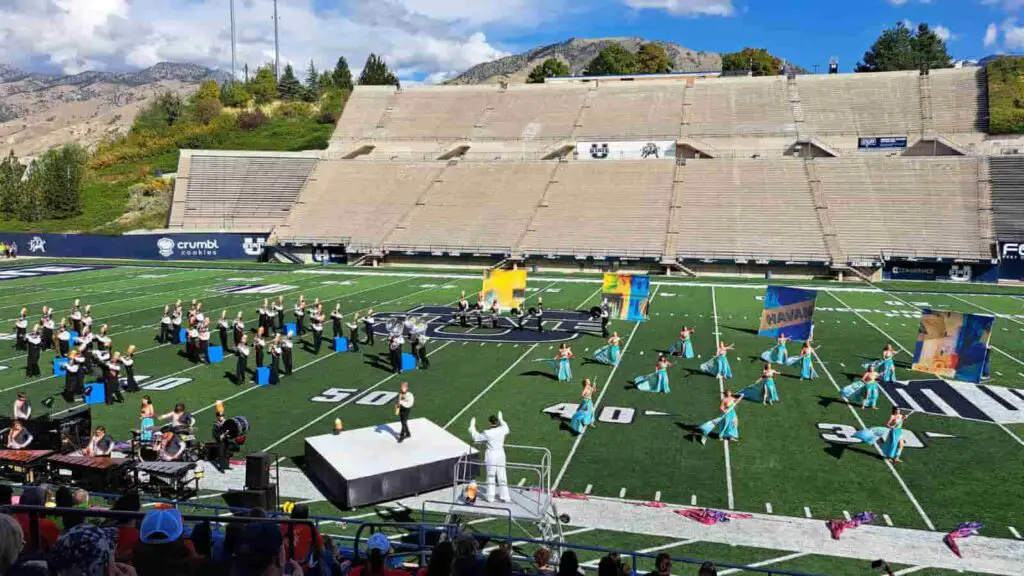
Color guard will often begin practice before the band as well as end practice after the band. There have been times when my daughter has to be to practice several hours before the marching band even shows up!
Color guard rarely gets the attention it deserves. You may see big crowds gathered for soccer or baseball games, but color guard usually only draws out the most loyal supporters. The crowds may be smaller, but those that do come LOVE to watch them perform.
Sometimes There is Drama
Drama is not something unique to color guard. Belonging to any group in high school or college has a tendency to create some drama.
Transitioning into young adulthood is full of changes. Hormones as well as going through new emotional experiences can cause things to get blown out of proportion very easily.
Since the color guard is historically mostly a female sport it goes without saying that there will be some members who don’t get along with each other, as well as they, would like.
As long as your color guard has clear rules and expectations with how to treat each other the drama can be kept to a minimum. Hazing and other inappropriate activities should be closely monitored by coaches and adults and prevented from happening.
🎵 Note: If you are scared to join color guard because you hear about how much drama there is within the group, give it a try anyway.
You may be surprised that it’s mostly hearsay and once you work together towards a common goal the drama will dissipate.
#10 Is Color Guard Worth it? Why you SHOULD join Color Guard, even though it’s hard!
So in spite of this list why would 99% of color guard members say it is 100% worth doing?
Sometimes the hardest things in life are the ones most worth doing!
Jennifer E Smith
It takes commitment and passion, but the rewards from participating in color guard far outweigh the difficulties.
Here are some of the reasons color guard members come back year after year.
- You make lifelong friends. School can be tough, but when you spend so much time with a group of people who have something in common with you and you share the same goals it makes it so much easier!
- You get to be part of a team. The rewards from accomplishing something as a team are huge. This can help you develop communication skills as well as give you opportunities for leadership and mentorship.
- You perform a beautiful show. The color guard adds so much beauty and color to the marching band show. They often get to have the most stunning outfits and coolest props. They are able to take a show from great to OUTSTANDING!
- Opportunities for scholarships. As you move forward in your skills many colleges are looking for talented members to offer scholarship money to.
- You learn how to manage your time. The amount of time you spend practicing and performing gives you an excellent chance at learning a very important skill that will benefit you for the rest of your life.
- You get rewards from learning a new skill. Learning a new skill, especially one as neat as color guard can be a lot of fun. It’s a fairly unique skill at that. You will be able to impress your friends and family at your next neighborhood talent show!
- You build muscle and stay lean. Color guard is a great way to get a lot of exercise that doesn’t involve boring repetitions of visits to the gym. You will gain physical endurance as you develop strong lean muscles!
- Learn about dance and how to emote with your body. Color guard members learn about dance moves but also how to portray the emotion of music with movements of your body. It can be a very powerful way to release the tension and stress of a long day!
It’s athletic, time consuming, tedious, painful, frustrating, and a lot of the worst parts of sports. But after stepping off that floor and hearing all the applause you get from the audience, the good far outweighs the bad.
Marissa from a Quora Post
I can do things now that I never imagined I’d be able to do. I can do incredible, complicated things with flags, rifles, and sabres that people’s jaws drop at. I think Colorguard is unique, and fun, and so so rewarding and that is why I love it!
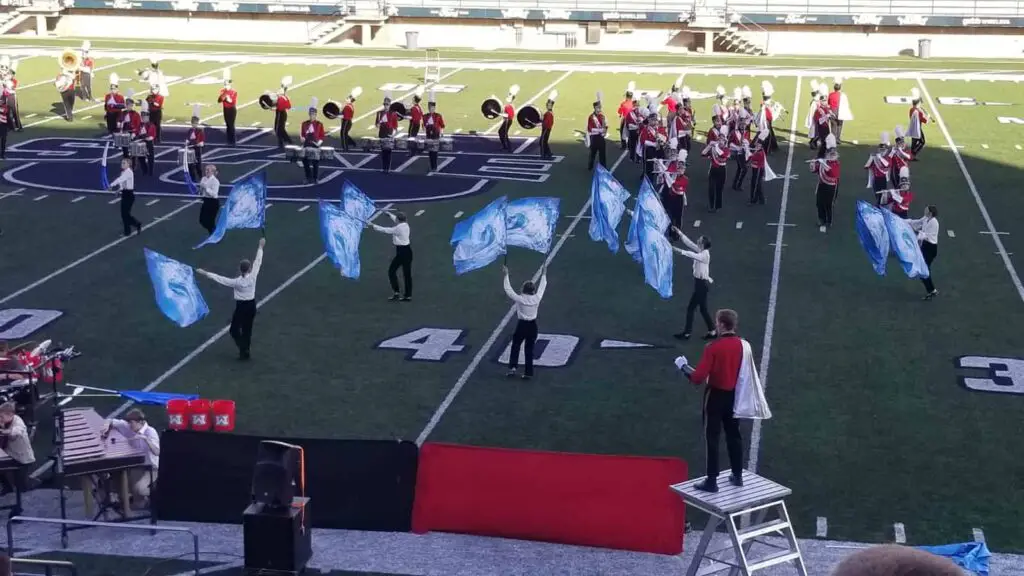
We hope this article has been helpful and informative for you in your musical journey. Please let us know if there is anything that we could add or change to make this article a better resource for our readers.
Please e-mail us at: [email protected] to let us know how we are doing!
Disclaimer: This post may contain affiliate links. We only recommend high-quality products that are used and recommended by real musicians. If you use these links to buy something we earn a small commission.
